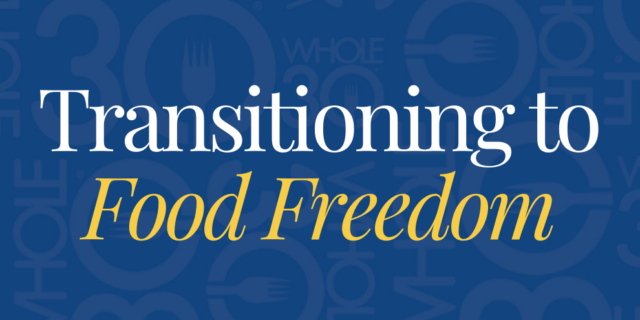Congratulations! You completed 30 days of Whole30 elimination. It was hard, but worth it. You’ve got a long list of non-scale victories, new healthy habits, and a renewed sense of self-confidence. But you know it’s not over yet! You’re heading into phase two of the Whole30: reintroduction.
Read more about what to expect during your Original Whole30 reintroduction (or the Plant-Based version) on our website or in The New Whole30.
During elimination, you mostly knew what to expect. Our Whole30 Timeline is eerily accurate in predicting what you’ll be thinking and feeling during each week of elimination. But reintroduction is different.
Because every body reacts differently to different foods, there is no “typical” reintroduction experience. In fact, Whole30 reintroduction symptoms can vary tremendously—but I can still offer a preview of what to expect. Knowing what to look for and how to evaluate your results can help you make the most of reintroduction, and lay a solid foundation for your food freedom.
During reintroduction, you’ll be evaluating the impact of the previously eliminated food groups as you bring them back into your diet. Reintroduction symptoms can manifest themselves physically, mentally, or emotionally. They may be noticed immediately, a few hours from your meal, or the next day. The effects may be severe and easily noticeable, or mild and subtle.
In addition, the reintroduced foods may not impact you at all! You may not notice any changes, or feel any differently throughout the day. In fact, some reintroduction foods may have a positive impact on your energy, mood, digestion, satiety, or athletic performance. It’s important to keep an open mind, and to stay present and aware during reintroduction.
Here are the answers to some common questions about what to expect during Whole30 reintroduction.
What are the most commonly reported reintroduction symptoms?
While there is no one-size-fits-all experience, there are some reintroduction symptoms that come up more than others. These include:
- Headaches
- Bloating
- Stomach pain
- Diarrhea
- Poor energy/energy crashes
- Cravings
- Anxiety
- Brain fog
- Skin reactions
- Respiratory/sinus issues
- Inflammation
During reintroduction, you may notice that increased inflammation may present as pain, swelling, redness, or reduced functionality. The symptoms of your medical condition (like arthritis, blood-sugar regulation, or autoimmune disease) may come back, become more difficult to manage, or get worse. With some food groups, you may feel like you went back to feeling “like you used to.”
Reintroduction symptoms can also affect you mentally or emotionally. Some report feeling “down” or unmotivated with certain food groups. Others have said reintroduction groups have brought back “food noise,” rumination, or a return to old habits.
Should I expect these food groups to bring on negative symptoms?
Absolutely not. It’s just as likely that reintroduced foods won’t bring about any negative effects. In fact, some groups may even lead to an improvement in energy, sleep, mood, or athletic performance!
Remember, we don’t eliminate foods on the Whole30 because they’re “bad” or unhealthy. These food groups can be problematic, but they may just as well not present a problem for you. That’s why it’s important to keep an open mind during Whole30 reintroduction, and track your results carefully.
Could your Whole30 reintroduction “symptoms” be all in your head?
They could be! The placebo effect is very real. This is why healthcare practitioners recommend repeating elimination and reintroduction at least once. Doing the Whole30 again in the future can confirm your reintroduction results, or offer more nuance to the way various foods impact you.
If you go into reintroduction expecting these foods to be problematic, you will almost certainly find evidence of that. As such, we encourage you to come into reintroduction with an open mind. Don’t assume you’ll experience negative results with any particular food or food group. Remember that everyone’s reintroduction experience is unique, so just because some people find an ingredient problematic doesn’t mean you will too. It’s just as possible that some or most of these foods will work fine in your body.
That having been said, do trust your body. If you notice your tendinitis is nagging, your focus isn’t as clear, or your anxiety seems heightened, track that response. (It may help to rank them on a scale of 1-10.) If you’re surprised that a particular food is having such an impact, note that too! You’ll be able to confirm, refute, or refine your findings as you continue to eat that ingredient in your food freedom.
If I do have Whole30 reintroduction symptoms, will they likely be mild or severe?
Either of the above—or somewhere in between. Some people notice immediate and/or notable symptoms immediately after consuming a specific food. These are often folks who came into the program with an inflammatory condition (like arthritis, tendinitis, or asthma), an autoimmune disease, or a digestive disorder. Others may not notice anything right away, but have symptoms like bloating, respiratory issues, breakouts, or energy crashes later that day, or the next. Still others might not notice anything during the reintroduction period, but with repeated exposure post-Whole30, a pattern of symptoms begins to emerge.
If I am sensitive to any of these foods, will reintroducing them erase all of my Whole30 benefits?
Absolutely not. One day of reintroduction will not “undo” 30 days of healing, calming, and restoring balance. You may have an unpleasant day or two, but the inflammation, resurgence of symptoms, or energy disturbances are temporary. This is why we have you return to the elimination phase for 2-3 days (or more) between each reintroduction group. Should you encounter any Whole30 reintroduction symptoms, you’ll have the days following to allow your symptoms to pass. You won’t reintroduce your next food group until you decide you’re back to feeling “Whole30 good,” whether that takes a few days or a week.
Whole30 reintroduction resources
Now that you have a better understanding of what to expect during Whole30 reintroduction, we hope you’re feeling much more confident and prepared. You can also brush up on this Whole30 phase using these resources:
- The New Whole30 (starting on pages 24 and 83)
- Why does reintroduction feel so hard?
- How to prepare for Whole30 reintroduction
- Don’t make these 4 reintroduction mistakes
Remember, without reintroduction, there is no food freedom. Take the time to plan, prepare, and document your results here, and those learnings will pay off for years to come.
Disclaimer: This page contains affiliate links. We earn a small commission when you purchase through these links.
















